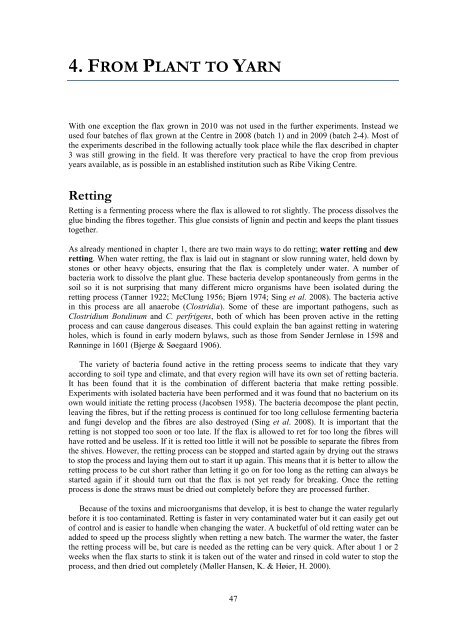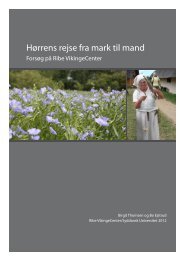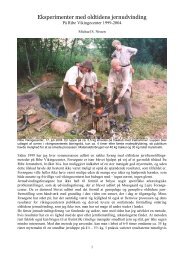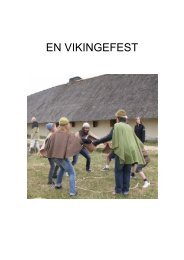From flax to linen. Experiments with flax - Ribe VikingeCenter
From flax to linen. Experiments with flax - Ribe VikingeCenter
From flax to linen. Experiments with flax - Ribe VikingeCenter
Create successful ePaper yourself
Turn your PDF publications into a flip-book with our unique Google optimized e-Paper software.
4. FROM PLANT TO YARN<br />
With one exception the <strong>flax</strong> grown in 2010 was not used in the further experiments. Instead we<br />
used four batches of <strong>flax</strong> grown at the Centre in 2008 (batch 1) and in 2009 (batch 2-4). Most of<br />
the experiments described in the following actually <strong>to</strong>ok place while the <strong>flax</strong> described in chapter<br />
3 was still growing in the field. It was therefore very practical <strong>to</strong> have the crop from previous<br />
years available, as is possible in an established institution such as <strong>Ribe</strong> Viking Centre.<br />
Retting<br />
Retting is a fermenting process where the <strong>flax</strong> is allowed <strong>to</strong> rot slightly. The process dissolves the<br />
glue binding the fibres <strong>to</strong>gether. This glue consists of lignin and pectin and keeps the plant tissues<br />
<strong>to</strong>gether.<br />
As already mentioned in chapter 1, there are two main ways <strong>to</strong> do retting; water retting and dew<br />
retting. When water retting, the <strong>flax</strong> is laid out in stagnant or slow running water, held down by<br />
s<strong>to</strong>nes or other heavy objects, ensuring that the <strong>flax</strong> is completely under water. A number of<br />
bacteria work <strong>to</strong> dissolve the plant glue. These bacteria develop spontaneously from germs in the<br />
soil so it is not surprising that many different micro organisms have been isolated during the<br />
retting process (Tanner 1922; McClung 1956; Bjørn 1974; Sing et al. 2008). The bacteria active<br />
in this process are all anaerobe (Clostridia). Some of these are important pathogens, such as<br />
Clostridium Botulinum and C. perfrigens, both of which has been proven active in the retting<br />
process and can cause dangerous diseases. This could explain the ban against retting in watering<br />
holes, which is found in early modern bylaws, such as those from Sønder Jernløse in 1598 and<br />
Rønninge in 1601 (Bjerge & Søegaard 1906).<br />
The variety of bacteria found active in the retting process seems <strong>to</strong> indicate that they vary<br />
according <strong>to</strong> soil type and climate, and that every region will have its own set of retting bacteria.<br />
It has been found that it is the combination of different bacteria that make retting possible.<br />
<strong>Experiments</strong> <strong>with</strong> isolated bacteria have been performed and it was found that no bacterium on its<br />
own would initiate the retting process (Jacobsen 1958). The bacteria decompose the plant pectin,<br />
leaving the fibres, but if the retting process is continued for <strong>to</strong>o long cellulose fermenting bacteria<br />
and fungi develop and the fibres are also destroyed (Sing et al. 2008). It is important that the<br />
retting is not s<strong>to</strong>pped <strong>to</strong>o soon or <strong>to</strong>o late. If the <strong>flax</strong> is allowed <strong>to</strong> ret for <strong>to</strong>o long the fibres will<br />
have rotted and be useless. If it is retted <strong>to</strong>o little it will not be possible <strong>to</strong> separate the fibres from<br />
the shives. However, the retting process can be s<strong>to</strong>pped and started again by drying out the straws<br />
<strong>to</strong> s<strong>to</strong>p the process and laying them out <strong>to</strong> start it up again. This means that it is better <strong>to</strong> allow the<br />
retting process <strong>to</strong> be cut short rather than letting it go on for <strong>to</strong>o long as the retting can always be<br />
started again if it should turn out that the <strong>flax</strong> is not yet ready for breaking. Once the retting<br />
process is done the straws must be dried out completely before they are processed further.<br />
Because of the <strong>to</strong>xins and microorganisms that develop, it is best <strong>to</strong> change the water regularly<br />
before it is <strong>to</strong>o contaminated. Retting is faster in very contaminated water but it can easily get out<br />
of control and is easier <strong>to</strong> handle when changing the water. A bucketful of old retting water can be<br />
added <strong>to</strong> speed up the process slightly when retting a new batch. The warmer the water, the faster<br />
the retting process will be, but care is needed as the retting can be very quick. After about 1 or 2<br />
weeks when the <strong>flax</strong> starts <strong>to</strong> stink it is taken out of the water and rinsed in cold water <strong>to</strong> s<strong>to</strong>p the<br />
process, and then dried out completely (Møller Hansen, K. & Høier, H. 2000).<br />
47






